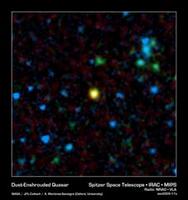Voracious black holes hide their appetite in dusty galaxies
 | A UK-led team of astronomers reports today (August 4th) in Nature that they have tracked down an elusive population of black holes growing rapidly hidden behind clouds of dust. Download Full High Resolution Image |
Growing black holes, known as quasars, are some of the brightest objects in the Universe and are seen by the light emitted as gas and dust spiral into the black hole. Quasars are situated in the inner-most regions of galaxies and can consume the equivalent mass of between ten and a thousand stars in one year! Astronomers believe that all quasars are surrounded by a dusty ring which hides them from sight on Earth in about half of cases.
However, examining the cosmic x-ray background, which is made up primarily of the emissions from quasars, astronomers realised that there should be many more obscured quasars than currently known. Objects surrounded by dust are hard to see with visible light, so the astronomers looked at infrared wavelengths, which are less likely to be reflected away. Using NASA's Spitzer Space Telescope's First Look Data, they were able to find a new population of obscured quasars. The new quasars have no spectra that can be seen and are thought to be hidden behind the dust of the galaxy itself rather than just a dust ring. The presence of lots of dust in a galaxy indicates that stars are still forming there. The researchers found 21 examples of these lost quasars in a relatively small patch of sky. All of the objects were confirmed as quasars by the National Radio Astronomy Observatory's Very Large Array radio telescope, New Mexico, and the Particle Physics and Astronomy Research Council's William Hershel Telescope on La Palma.
Alejo Martinez-Sansigre from the University of Oxford explains "We were missing a large population of obscured quasars, which had been inferred from studies at X-ray frequencies. This newly discovered population is large enough to account for the X-ray background, and now we wish to find out why there are more obscured quasars than unobscured ones".
From their study, the team believes that there are more quasars hidden by dust than not and that most black holes grow in short, efficient bursts at the heart of growing galaxies.
Professor Richard Wade, Chief Executive of the Particle Physics and Astronomy Research Council which supports the University of Oxford Astrophysics group said "The new population of Quasars suggest that throughout cosmic history most black holes grow in the heart of dusty active galaxies with stars still forming."
Notes for Editors
1. NASA's Jet Propulsion Laboratory (JPL) manages the Spitzer Space Telescope mission for NASA's Science Mission Directorate, Washington. Science operations are conducted at the Spitzer Science Center at the California Institute of Technology (Caltech) in Pasadena, Calif. JPL is a division of Caltech. Additional information about the Spitzer Space Telescope is available on the website.
2. The Isaac Newton Group of Telescopes (ING) is an establishment of the Particle Physics and Astronomy Research Council (PPARC) of the United Kingdom, the Nederlandse Organisatie voor Wetenschappelijk Onderzoek (NWO) of the Netherlands and the Instituto de Astrofísica de Canarias (IAC) in Spain. The ING operates the 4.2-metre William Herschel Telescope, the 2.5-metre Isaac Newton Telescope, and the 1.0-metre Jacobus Kapteyn Telescope. The telescopes are located in the Spanish Roque de Los Muchachos Observatory on La Palma, Canary Islands, which is operated by the Instituto de Astrofísica de Canarias (IAC).
3. The paper can be viewed online here.
Contacts
Julia Maddock PPARC Press Office Tel +44 1793 442094
Alejo Martinez-Sansigre University of Oxford Tel +44 1865 273 337
NASA Contact Whitney Clavin Jet Propulsion Laboratory, Pasadena, California Tel +1 818-354-4673 Chris Willott National Research Council Canada Tel +1 250 363 8103 About PPARC
more at black holes or galaxies and astronomy or Universe and PHYSICS











No comments:
Post a Comment